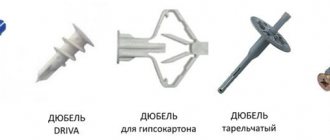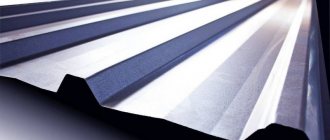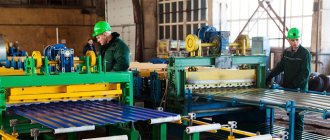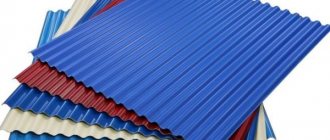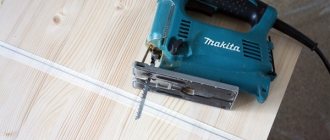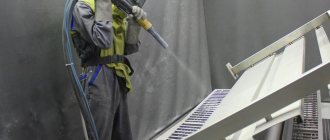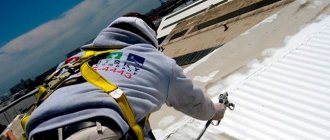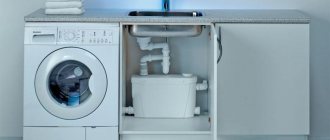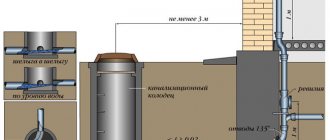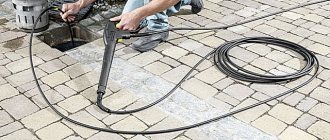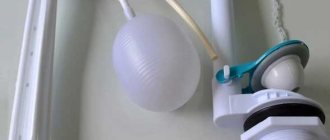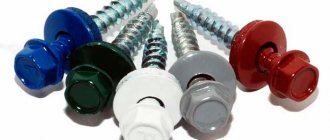Correct fastening of corrugated sheeting on the roof with self-tapping screws
When installing the outer surface of the roof, a very important point is the correct use of fasteners. In strong winds, the tearing loads on the finishing coating can be up to 600 kilograms per square meter. In addition, excessive deformation of the sheet when tightening the screw can lead to a violation of the tightness of the roof at the place of its installation. This often leads to the need to completely reassemble the roofing pie in order to determine the location of the leak and eliminate it. The first thing you need to understand is what kind of screws are needed for corrugated roofing. Not every screw is suitable for this, so you need to select special fasteners that ensure the force of pressing the sheet to the sheathing and the tightness of the fastening.
Design of special fasteners for corrugated sheets with a sealing washer Source ohiogas.info
Select fasteners that match the color of the roof covering and are equipped with an elastic plastic sealing washer.
When screwing the screw, a screwdriver with tightening force control is used. The screw is installed in the cavity strictly perpendicular to the surface of the corrugated sheet; during installation, the surface should not bend inward. If there is a skew when screwing, the screw must be unscrewed, a wooden plug must be driven into the hole using PVA-M glue and the self-tapping screw must be installed correctly.
For the final roof covering, profiled sheet CH35 or CH45 is used. Accordingly, fasteners are used in the form of self-tapping screws with a length of 20 to 50 millimeters:
- when installed in a cavity of a sheet - 20 mm long;
- when installed where adjacent sheets overlap – 50 mm;
- for attaching a ridge strip through corrugated sheeting - 50 or more millimeters, depending on the roof structure. In some cases, longer fasteners can be used.
When purchasing screws, you need to take into account a large percentage of their quality rejection. The main disadvantage of the screws is that the drill end is not sharp enough, which can lead to rolling of the edges of the holes and deformation of the sheet. The screw diameter is selected within the range of 4.8-6.3 millimeters.
To the rules for installing fasteners on corrugated sheets Source stroitel-list.ru
Selection of fasteners
Attaching the corrugated sheet to the sheathing can be done using various fastening elements, each of which has its own characteristics and parameters. The strength and durability of the fixation depends on the correct choice of these items. If fasteners are chosen incorrectly, the quality of fastening will be low, and this will negatively affect the service life of the roof.
The best options for fixation are:
- Galvanized self-tapping screws. They must be equipped with a fairly wide cap. The products are formed using galvanized steel, which has excellent resistance to corrosion. Due to the presence of a wide cap, the space under the roof is protected from moisture penetration.
- Self-tapping screws equipped with a press washer. It can be made of rubber or polyurethane. These fasteners are specially manufactured for working with roofing, as they provide reliable protection of the under-roof space from moisture. In this case, the screws fit tightly to all sheets of corrugated board at the fastening points. The cost of such elements is considered quite high, but it is advisable to initially spend money on high-quality fasteners so that in the future there is no need to spend a lot of money on roof repairs.
Important! If you use standard self-tapping screws for work, then these fasteners will not last too long in the existing conditions, and a small cap will also allow moisture to penetrate into the existing hole into the under-roof space.
High-quality galvanized screws for corrugated sheets have different colors, which allows you to choose the optimal products for specific sheets that have a specific shade. It is not allowed to fasten corrugated sheets using welding or nails. High temperatures contribute to the destruction of the protective layer of the material, so the corrosion process soon begins on the sheets. The nails will not be able to withstand strong winds, so there is a possibility that the sheets will be torn off the roof.
How to properly install corrugated sheets on the roof
The roof is installed in a certain order, ensuring its strength and tightness.
Installation of individual sheets begins from the lower left end. On the first vertical row there is a gable overhang no more than 40 centimeters wide. But the sheets are not stacked in order, but in a checkerboard pattern, that is, the second will be the first sheet of the second vertical row, then the second of the second vertical row, then the second of the first. In this way, the slope of one side of the roof is formed, after which the installation of the second begins in the same order. The verticality of the rows must be controlled with a mounting cord.
The vertical overlap of the sheets should be at least 20 centimeters; horizontally, this figure depends on the design of the corrugated sheet. Under normal conditions, such an overlap is performed in one wave, in more severe climatic conditions - in two. The decision is made at the design stage depending on the climatic conditions in the construction region.
Scheme of fastening a sheet of corrugated sheets on the roof Source legkovmeste.ru
For a standard sheet 0.8x1.1, the distance between the screws is 0.5 meters, that is, there are 4 pieces per 1 m2. But you need to take into account that along the lower edge of the sheet of the first row of the roofing pie, fasteners are installed in each lower shelf.
The gable edges of the finishing coating are attached at intervals of about 250-300 millimeters. In addition, overlapping side, ridge and wind strips are attached with the same parts, increasing their specific consumption.
The average consumption of fasteners is taken to be 8 pieces per square meter, with 4 pieces 35 mm long, 2 pieces 20 mm and the same number longer, from 50 mm. But you need to keep in mind that this indicator directly depends on many factors:
- roof structures;
- thickness of finishing coating sheets;
- applied profile.
Laying technology
Corrugated sheeting is a modern roofing material that is used to cover roofs with a slope of 8 degrees or more. The technology for laying the material depends on the angle of inclination of the slopes of the structure. The sheets are installed with an overlap to ensure the tightness of the joints. Considering the light weight of the corrugated sheet, a roof with such a coating has a high windage capacity and experiences intense wind loads, so the pitch between the screws should not exceed 50 cm. The corrugated sheeting is laid as follows:
- Pitched roofs begin to be broken from the bottom of the end, laying the first sheet with a protrusion of 2-3 cm.
- When laying, the top row is always laid on the bottom to prevent melt or rain moisture from flowing into the joints.
- The horizontal minimum overlap between sheets is 10 cm, which is 1 wave. The lower the roof slope, the greater the overlap.
- The vertical overlap between the sheets is 20-25 cm.
- If the angle of the roof slopes is less than 15 degrees, the vertical and horizontal joints are treated with silicone-based sealant to reliably seal the seams.
- Each sheet is secured to the bottom and top battens of the sheathing in each wave, the remaining screws are screwed in in a checkerboard pattern so that the maximum distance between them does not exceed 50 cm.
- The fasteners are screwed into the lower part of the wave adjacent to the sheathing so that when a wind load appears, a lever effect does not occur.
- A ridge profile is installed at the connection of the slopes, fixing the part with self-tapping screws in each wave.
Layout of corrugated sheets
Method of fastening corrugated sheets
Please note that after installation it is important to monitor the condition of the fasteners on the roof surface. They should not become loose or untwisted. To prevent intense wind loads from leading to deformation of the roof, it is necessary to quickly tighten it using a screwdriver. If pockets of rust appear at the fastening points, it is better to replace the screws with galvanized ones.
Determining the amount of fasteners per sheet of corrugated sheeting
The easiest way to answer this question would be to simply count. If there are 8 screws per 1 square meter of roofing, and its area is: 0.8 x 1.1 = 0.88, it is logical to recalculate this way: 8 x 0.88 = 7 pieces, rounded. But in this case there is simply no point in calculating the specific consumption of fasteners; it is much easier to calculate the total roof area and use the generally accepted consumption rate per square meter. This value is always calculated when designing a structure. In addition, such a calculation is made taking into account the features and dimensions of the profile.
How to properly fasten a corrugated sheet with self-tapping screws Source raflon.ru
Characteristics of corrugated sheets
- installation of roofs;
- organization of ventilated facades;
- construction of fences and light buildings.
- made of galvanized steel;
- made of galvanized steel using a polymer coating 50 microns thick.
- light weight;
- environmental friendliness;
- ease of installation;
- long service life;
- high resistance to corrosion;
- wide selection of colors and sizes (read: “Metal profile sheet for roofing: dimensions”).
Video description
You can see how to install a profile from corrugated sheets in the following video:
Installation is carried out in the following order:
- of board sheathing - sparse or solid. The latter is carried out with a distance between boards of up to 5 centimeters; the sparse packing step provides for a distance between boards of up to a meter, depending on the format of the finishing sheets.
- The boards are stuffed horizontally starting from the bottom edge of the rafter system.
- Two or three boards in the ridge space are installed closely without gaps .
- waterproofing is installed on top of the sheathing. The flooring starts from the bottom edge of the roof. The sheets are laid with an overlap of up to 15 centimeters, the joint is glued with construction tape or joined using bitumen mastic.
The main task of waterproofing is to seal the supporting base for the finishing coating and drain condensate from the under-roof space.
This coating structure is used when installing a “cold” roof. To make it warm, you need to form a roofing pie using insulation and vapor barrier films. The use of roof insulation reduces heating costs by up to 20-30%.
How to make a sheathing for corrugated sheets from sheet materials Source qor.vogemuqa.ru.net
Laying waterproofing and vapor barrier
For the reliability and durability of the roof, it is necessary to install waterproofing and vapor barrier materials.
Waterproofing is laid between the sheathing elements and corrugated sheeting directly on the insulation (if its use is intended) to protect the attic space and insulation from moisture. The lack of waterproofing leads to the fact that moisture is not removed from under the roof, but accumulates in the form of condensation on profiled metal sheets. The result of this is the formation of corrosion centers and a reduction in the service life of the roofing material.
The vapor barrier is laid under the insulation and prevents the formation of condensation, which always forms due to the difference in temperature from the outside and inside of the roof.
The number of layers of the roofing pie is determined by the functional purpose of the structure.
For example, residential properties require vapor barrier, insulation, waterproofing and roofing material. For non-residential premises, it is sufficient to lay waterproofing material under the corrugated sheet.
Roofing installation
Fastening the corrugated sheeting with self-tapping screws on the roof, as mentioned above, is done from the lower left corner of the slope. The work is carried out in the following order:
- First of all, a drip tray is installed - a special strip for draining condensate from the under-roof space into storm water inlets.
- The first sheet is laid on the sheathing parallel to the rafters, thereby forming the amount of overhang. For a standard sheet it should be no more than 40 centimeters.
- Correct fastening of corrugated sheeting on the roof with self-tapping screws is carried out taking into account the above requirements - installation in the stream at a right angle.
Scheme for installing corrugated sheets on the roof Source iv-proect.ru
Technology for installing a roof made of profiled decking
The technology for installing a profiled roof is similar to the method of attaching corrugated sheeting to a fence. The laying of a universal material has a number of nuances that must be taken into account during the overlapping process. Profiled sheets are laid with offsets between the rows, overlapping the sheathing.
Basic rules for fastening profiled sheets
Before attaching corrugated sheeting to the roof, you should study the recommendations for working with the coating. The service life of the structure depends on the quality and correctness of installation. Like fasteners for fences made of corrugated sheets, roofing uses its own fixation rules:
- If the roof has a slight slope, less than 15 degrees, then the horizontal overlap is about 20 cm between the sheets. Flattering designs allow the joints to be increased to 5 cm.
- When the slope of the slope exceeds 30 degrees, the optimal overlap of sheets on top of each other is 10-15 cm.
- For roofing at an angle of 15-30 degrees, the sheets are overlapped by 15-20 cm.
By adhering to the rules for joining embossed metal profiles, you can prevent the formation of long vertical seams, which will subsequently allow moisture to pass through. An evenly and correctly fixed sheet ensures the reliability of the ceiling system.
Laying insulating materials
The insulation device provides reliable protection of the roof from precipitation and the accumulation of condensation in the structure from temperature changes:
- A special foil membrane is used as a vapor barrier material, which is laid on the base of the structure. Wooden slats are mounted on top of the film, cutting off the ventilation gaps.
- Waterproofing for roofs is done with roofing felt or liquid bitumen.
- If thermal insulation is necessary, ecowool or fiberglass should be used.
When carrying out insulation, keep in mind that some of the activities are carried out from the attic side of the house.
Cutting corrugated sheets
If it is necessary to adjust individual cards to the installation site, various methods are used. It should be noted right away that cutting methods may be different, but you should immediately warn against using technologies that lead to heating of the sheet, for example, cutting with a grinder. In this case, the paint coating peels off, leading to its further destruction at an accelerated rate.
You should use other available methods: hand or mechanical metal scissors or a jigsaw.
Cutting corrugated sheets with metal scissors Source legkovmeste.ru
Preparing the sheathing for covering
Before installation, it is necessary to make a high-quality sheathing. It is made from wooden planks treated with an antiseptic composition. It prevents rotting due to condensation dripping from the inside of the roof. During installation, it is necessary to correctly determine the distance between the planks (sheathing pitch) and the distance between the screws.
Based on SNiP data, the following rules for its calculation are recommended:
- with a profile height of 35 mm (HC35) and an inclination angle of up to 15º - up to 0.5 m, more than 15º - 1 m;
- with a profile height of 60 mm (H60) and an inclination angle of 8º – no more than 3 m;
- with a profile height of 70 mm (H75) and an inclination angle of 8º – no more than 4 m;
NOTE! There must be a ventilation gap between the sheathing and the waterproofing. To create it, a counter-lattice is installed from rafter strips or metal purlins attached along the rafters.
Which screws are suitable for installing corrugated roofing
For this coating, special fasteners are used. In Russia, self-tapping screws for corrugated roofing are produced taking into account the requirements of GOST 17917-86. A distinctive feature of such screws is the presence of a drilling part at the front end, which allows drilling of the material while the screw is being screwed in. The second feature is that the head is hexagonal in shape, and the manufacturer’s hot stamp is applied to the end. There is also a support washer with a plastic spacer underneath it. (See Figure 2.)
The use of other fasteners, as a rule, leads to numerous leaks in the roof covering.
Selecting the brand of material
When thinking about which corrugated sheeting to use for the roof, it is important to know its numerical index. According to the wave height and sheet thickness, several types of material are distinguished
Profile marked C21
Available in the form of a trapezoid of standard length (2, 3 and 6 m). To complete the roof, you need to focus on the dimensions of the corrugated sheeting: width 1.05 m, wave height 21 microns and thickness 0.4 - 0.7 mm. The metal material is suitable for creating a roof covering on sparse sheathing or as garage cladding.
Roofing profiled sheet C44
It is most convenient to work with sheets with a width of 1.47 m. The height of the corrugated sheet laid on the roof is 44 microns, and the thickness varies from 0.5 to 0.8 mm. The profile is reinforced with additional stiffening ribs and provides for the construction of a roof on sheathing in increments of 2 m, as well as frames for gazebos or cabins.
Corrugated sheeting with index NS45
The construction of a home roof can be carried out from corrugated sheets with a width of 1.06 mm. The recommended thickness is 0.5-0.8 mm, and the profile height is 35 mm. The rigidity and strength of the material guarantee the reliability of the roofing on the sheathing in increments of 4.5 m. Having decided on the material, do not forget that its price depends on the alphanumeric index.
What is corrugated sheeting and what types of it exist?
First, let's explain what corrugated sheeting is and what subtypes it is divided into. This material is rolled steel sheets with a wavy profile, the width and height of the projections of which are regulated by standards. Thanks to this shape, the profiled sheet has significant rigidity with a small metal thickness.
Profiled sheets
To protect against corrosion, corrugated sheets are coated on the outside with protective materials - galvanized or polymer film. The latter gives the material a certain color.
Important: there are several options for the protective coating of corrugated sheets - polyester, the most common option, polyester with Teflon - is less common, but has improved protection from the negative influences of the external environment. There are also steel sheets, PVC and PVDF exterior coating - they are more expensive, but at the same time they have the highest possible resistance and durability for the material.
Features of various corrugated sheet coatings
There are three main types of profiled sheets, each of which is suitable for creating certain structural elements of a building. Let's get acquainted with this classification of material using the table below.
Table. Main brands of profiled sheets.
| Code designation of the corrugated sheet brand | Function performed |
| C – wall profiled sheet | Thin sheets with low height profiled parts. They are used in the construction of fences, simple canopies and walls that do not bear a significant load. It is not advisable to use it for roof cladding - the material is not strong enough and in winter it can bend under the thickness of snow and ice. |
| NS – load-bearing-wall profiled sheet, also called universal | Steel sheets with average strength characteristics can be simultaneously used both as wall and load-bearing corrugated sheeting, but in the latter case there is a limitation on permissible loads. It can be used as a material for roof cladding, but only if the amount of snow falling in the area where the house is located is not too large. |
| N – load-bearing profiled sheet | Profiled sheets with great thickness and high profile. They are more expensive, but at the same time have increased strength. Used to create load-bearing structures. Recommended for roof cladding. |
Important: after the letter designation of the profiled sheet brand there is a number - it indicates the height of the corrugation of the material in millimeters. When purchasing, pay attention to it.
Dimensions of corrugated sheets (corrugated sheets) according to GOST
The quality of the purchased material is one of the most important components of the strength and reliability of the roof. Therefore, here are a few simple rules that will help you choose good corrugated sheeting.
- Know the manufacturer of the material you plan to use - study the reviews, find out if any of your friends or neighbors have used this corrugated sheet.
- Be sure to check the main dimensions of the profiled sheets - length, width and height of the corrugation.
Choosing roofing sheeting
- Ensure that the material has been stored under appropriate conditions and is free of dents, scratches and other defects that could compromise the protective coating of the steel sheets.
- Check the quality and integrity of the packaging for the corrugated sheet.
- If you have any doubts about the quality of the profiled sheet, ask for certificates and other documents confirming the quality of the material and compliance with standards.
Recommendations for purchasing corrugated sheets
Important! When planning to sheathe a roof with corrugated sheeting, pay attention not only to the brand, size and quality of the material, but also to its color - it should be in harmony with the walls and base of the building and not blend in with the surrounding space.
Having dealt with the question of what color corrugated sheeting is, you will need to start choosing a shade that will ideally suit a particular home.
Prices for corrugated sheets
Corrugated sheet
